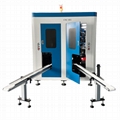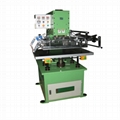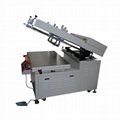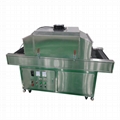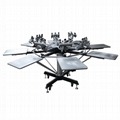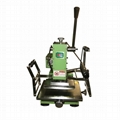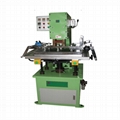| Model: | HM-TC3045LT |
|---|---|
| Brand: | KC |
| Origin: | Made In China |
| Category: | Industrial Supplies / Packaging Related Machine |
| Label: | hot stamper , hot stamping machine , hot foil stamping |
| Price: |
US $1618
/ pic
|
| Min. Order: | 1 pic |
| Last Online:23 Aug, 2025 |
Large-size manual flat hot stamping machine
1. Applicable material characteristics and hot stamping key points
• Leather:
• Characteristics: Leather is flexible and elastic, with a variety of surface textures. Natural leather such as cowhide and sheepskin has a tough texture, while artificial leather is relatively smooth.
• Hot stamping key points: When hot stamping, the pressure needs to be adjusted according to the thickness and flexibility of the leather. For thicker leather, sufficient pressure should be applied to ensure that the hot stamping pattern is fully transferred, but not too much to avoid damaging the leather texture. Temperature control is also critical, generally around 100-140℃, to prevent the leather from deforming or hardening due to high temperature. For example, when making high-end leather bags, in order to stamp the brand logo on the surface of the bag, it is necessary to accurately control the pressure and temperature so that the hot stamping pattern is clear, firm and does not affect the leather texture.
• Paper:
• Characteristics: There are many types of paper, including cardboard, coated paper, kraft paper, etc., and their thickness, texture and water absorption vary. Cardboard is thicker and harder, coated paper has a smooth surface and poor water absorption, while kraft paper is relatively rough.
• Key points for hot stamping: For thin paper, such as ordinary writing paper, the hot stamping pressure should be light to avoid paper cracking, and the temperature can be controlled at 80-120℃. For thick cardboard, the pressure can be increased appropriately, and the temperature can be slightly higher to ensure that the hot stamping pattern can be firmly attached to the surface of the paper. When making products such as greeting cards and book covers, the hot stamping parameters should be adjusted according to the specific type of paper so that the hot stamping pattern has good gloss and adhesion.
• Wood:
• Characteristics: There are different types of wood, such as pine, oak, mahogany, etc., and their density, hardness and surface smoothness vary greatly. Hardwood with high density has a smooth surface, while softwood may be rough.
• Key points for hot stamping: Due to the high hardness of wood, greater pressure is required for hot stamping, and the temperature is generally set at 120-160℃. At the same time, the wood surface may need to be pre-treated by grinding and other methods to make it smoother and smoother to achieve better hot stamping effect. For example, when hot stamping wooden crafts and furniture decorative parts, the wood surface should be properly treated first to ensure the clarity and firmness of the hot stamping pattern.
2. Structure and working principle of manual flat embossing hot stamping machine
• Structure:
• Body: Usually composed of a sturdy metal frame to provide stable support for the entire hot stamping process. The body design is simple and easy to operate and maintain.
• Heating plate and hot stamping plate: The heating plate is used to provide the heat required for hot stamping, and there are heating elements such as electric heating wires inside. The hot stamping plate is installed under the heating plate, with a flat surface, and is engraved or made according to the hot stamping pattern.
• Pressure device: Generally a manually operated lever or screw mechanism. The operator transfers the pressure to the hot stamping plate by manually pressing the lever or rotating the screw device, so that the hot stamping plate is in close contact with the workpiece.
• Workbench: A platform for placing leather, paper, wood, etc. for hot stamping. It has a flat and smooth surface and is usually equipped with a positioning device to help operators place the workpiece accurately.
• Working principle: Place the hot stamping foil on the surface of the workpiece (leather, paper or wood), and then place the workpiece on the workbench. Manually operate the pressure device to lower the hot stamping plate and make close contact with the workpiece. The heat provided by the heating plate melts the hot melt adhesive on the hot stamping foil. Under the action of pressure, the metal layer or pigment layer on the hot stamping foil is transferred to the surface of the workpiece to complete the hot stamping. At the same time, if the hot stamping plate has an indentation pattern, an indentation effect can also be formed on the surface of the workpiece.
3. Operation precautions and tips
• Preparation: Before hot stamping, make sure that the surface of the workpiece is clean and flat. For wood, proper polishing should be performed; for leather, dust and oil should be removed from the surface; for paper, it should be flat and wrinkle-free.
• Parameter adjustment: According to the characteristics of different materials, as mentioned above, the pressure, temperature and time of hot stamping should be reasonably adjusted. When you first start hot stamping, you can test it on a small piece of material and find the best parameters before doing batch operations.
• Hot stamping process: When manually operating the pressure device, apply force evenly to make the hot stamping plate fully contact the workpiece to avoid uneven local pressure that leads to incomplete hot stamping patterns or uneven indentations. Hot stamping time generally depends on the complexity of the material and the hot stamping pattern, usually between a few seconds and more than ten seconds.
• Post-checking and maintenance: After hot stamping is completed, check the quality of the hot stamping pattern, such as whether it is complete and clear, whether the color is uniform, whether the indentation meets the requirements, etc. For hot stamping machines, regularly clean the residue on the surface of the heating plate and hot stamping plate, and check whether the heating element and pressure device are working properly.
|
Manual hot stamping Machine //Structure |
||
|
Working table |
Manual in-out , size: 420*500mm. |
|
|
Stamping Head drive |
Manual , Level keeping pressure |
|
|
Foil collecting method |
Motor-drive , Collecting time adjustable |
|
|
Press |
Vertical press |
|
|
Temperature control |
Heater tube, automatically controlling |
|
|
Foil collecting |
Automatically collecting |
|
|
Press adjustment way |
Up-down of working table |
|
|
Manual hot stamping machine //Usage and characters |
||
|
Guide |
|
|
|
Application fields |
|
|
|
Manual hot stamping Machine //Parameter |
||
|
Technical parameters |
HM-TC3030LT |
HM-TC3035LT |
|
|
|
| HM-TC3040LT | HM-TC3045LT | |
|
|
|
|
Works supply |
|
|
|
Package list |
|
|
|
H.S.Code |
8443198000 |
|
|
Certificate |
CE |
|
|
Manual hot stamping machine //Advantage |
||
|
Function |
|
|
| Embed HTML Code: | |
|---|---|
| Application: | The semi-automatic hot stamping machine is mainly composed of the up and down of the hot stamping head, the conveying of the hot stamping paper, etc. We mainly name the hot stamping machine based on the control method of the hot stamping head up and down. Manual hot stamping machines are the simplest type of hot stamping machine. The conveyance of the hot stamping paper and the heating of the heating plate of the manual hot stamping machine still need electricity. The manual hot stamping machine is widely used in hot stamping processing in stores and small-scale factories, and can hot stamp most products such as paper, leather, plastic, and wood. |
